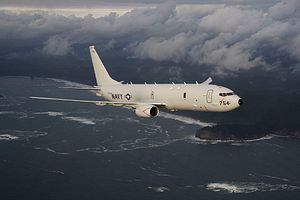South Korea is considering purchasing four Boeing P-8A Poseidon Maritime Surveillance Aircraft following North Korea’s successful launch of a KN-11 submarine-launched ballistic missile (SLBM) from a sub off its eastern coast near Sinpo on August 24, according to local media reports.
Speaking to the Korea JoongAng Daily newspaper, a senior government official confirmed that the Republic of Korea Armed Forces wants to increase its anti-submarine warfare capabilities with U.S.-made aircraft.
“North Korea is preparing a number of strategic ways to attack the South using its submarine fleet on top of the SLBM development,” said the official, “We are discussing whether to purchase the latest maritime patrol aircraft to detect North Korean submarines to prevent surprise attacks from under water.”
As I reported on August 31 (See: “Is North Korea Building a New Ballistic Missile Submarine?”), North Korean dictator Kim Jong-un allegedly ordered the construction of a new 3,000-ton diesel-electric submarine capable of firing ballistic missiles, according to a researcher. The North is currently operating one ballistic missile submarine—designated Sinpo-class–which, however, is still primarily a test platform with limited operational capability.
“Although we need to expand the reach of our surveillance in the aftermath of the SLBM success by the North, there are limits with the outdated antisubmarine patrol aircraft currently operated by the Navy,” the official said. Seoul wants to slowly phase out its fleet of obsolete P-3c Orion aircraft and in 2015 has expressed interest in acquiring up to 20 new maritime surveillance aircraft.
As I explained elsewhere, the Republic of Korea Navy (ROKN) wants to procure 12 Lockheed Martin twin-turbofan S-3 Viking anti-submarine warfare aircraft with the option of eight more from the United States. A contract is expected to be signed in 2018 and the aircraft are slated to reach initial operating capability in 2020. The planes would come from U.S. Navy surplus stock, as I noted in September 2015:
The United States retired its fleet of S-3 Vikings in 2009 and purportedly offered its surplus S-3 aircraft to South Korea and other allies thereafter. Between 1971 and 1978, a total of 187 S-3As were built. In the 1980s a much-improved S-3B version of the aircraft entered service specifically designed to counter quieter Soviet submarines. There are currently 91 S-3B models in storage out of which 87 could be refitted for active duty (…).
The Boeing P-8A Poseidon aircraft would complement the new fleet of S-3 sub-hunting planes. “We need to detect an enemy submarine when it surfaces in our waters. Doing so requires anti-submarine aircraft with wide surveillance coverage and high speeds,” a ROKN official told Korea JoongAng Daily. “The P-8 Poseidon equipped with the latest detection technology can enhance our operational capability.”
The P-8A Poseidon is one of the world’s most advance maritime patrol aircraft, as I summarized in early 2016:
According to the Boeing website, the P-8A aircraft “has twice the sonobuoy processing capability and can carry 30 percent more sonobuoys than any maritime patrol and reconnaissance aircraft currently flying.” It can also control a number of reconnaissance drones to extend sensor reach.
The P-8A has a range of up to 7,242 kilometers (4,500 miles) without refueling, reaches speeds of up to 490 knots, and “can fly in the “harshest maritime flight regimes, including extended operations in icing environments,” Boeing boasts.
The aircraft can carry several types of bombs, Raytheon Mark 54 lightweight torpedoes (which are turned into glide bombs and can be launched from up to 9,100 meters), mines, and depth charges, in addition to air-to-surface missiles installed on the underwing hardpoints.
South Korea first decided to increase its anti-submarine warfare capabilities following the sinking of a ROKN Pohang-class corvette on March 26, 2010 in the Yellow Sea, killing 46 seamen. The ship was purportedly sunk by a torpedo fired from a North Korean 130-ton Yono-class midget submarine, approximately ten of which are in service with the Korean People’s Navy, according to intelligence estimates.

































